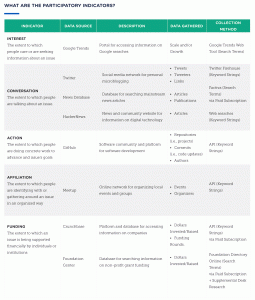Can We Quantify Social Movements?
Analytics Framework to Measure Social Movements
As the data partner of social good agency, Purpose, we were thrilled to contribute to this just-released report, “Engines of Change: What Civic Tech Can Learn from Social Movements.” This research for Omidyar Network, a philanthropic investment firm, maps the development of the civic technology movement through activity on social channels.
Stacy Donohue, Omidyar Investment Partner, presented some interesting insights at Personal Democracy Forum 2016, some of which are summarized in this post. The presentation is also reviewed in a Medium post by Lawrence Grodeska.
How do social movements form and how can we measure them? To answer these questions, Purpose has been developing and refining an innovative methodology, “Movement Measurement” to quantify the trajectory of social movements from inception to cultural event. The goal is to apply analytics to online indicators of cultural interest in an issue, beyond reporting of “likes,” “shares” or hashtag volume.
Capturing and sorting activity on authentic human participation through the lens of available online data is always difficult. Movements are generated and grow differently based on issue area, population and cultural resonance. In order to produce an analytical framework that can be applied across movements, categories of activity were created to approximate real-world activity that would be applicable in most cases. These categories include:
- Interest: people looking for information on the topic,
- Conversation: discussion about the topic,
- Action: concrete steps to make a change in the space
- Affiliation: gathering with other like-minded people
- Funding: sourcing of investment in the space
Table: Participatory Indicators
To populate each category with hard numbers, this analysis used resources such as Twitter, Meetup, Google Trends, Crunchbase, GitHub, and news reports. This wide-angle lens helps to identify drivers of movement-building activity and can demonstrate which types of activity are leading indicators of cultural movement.
The report’s key findings surface some excellent insights about civic tech and it is worth reading the full report, as well as the detailed methodology (p. 38). From an analytics perspective, this innovative approach helped to put a replicable framework around the intersection of social and real-world human activity. This framework will be a valuable tool to inform how we think about measuring social movements going forward.
In the interests of being good public citizens, the data sets used have been made available if you are so inclined to take our research further. Enjoy!






